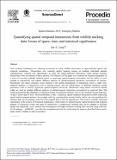Files in this item
Quantifying spatial-temporal interactions from wildlife tracking data : issues of space, time, and statistical significance
Item metadata
| dc.contributor.author | Long, Jed A. | |
| dc.date.accessioned | 2015-06-08T09:10:03Z | |
| dc.date.available | 2015-06-08T09:10:03Z | |
| dc.date.issued | 2015 | |
| dc.identifier | 193834990 | |
| dc.identifier | 9d7099ff-ccdf-4a81-9582-ac49bcd8296d | |
| dc.identifier | 000380492800002 | |
| dc.identifier.citation | Long , J A 2015 , ' Quantifying spatial-temporal interactions from wildlife tracking data : issues of space, time, and statistical significance ' , Procedia Environmental Sciences , vol. 26 , pp. 3-10 . https://doi.org/10.1016/j.proenv.2015.05.004 | en |
| dc.identifier.issn | 1878-0296 | |
| dc.identifier.other | RIS: urn:684B7DA409C347022111F2094ED7E4E6 | |
| dc.identifier.uri | https://hdl.handle.net/10023/6775 | |
| dc.description.abstract | New tracking technologies are allowing researchers to study wildlife movements at unprecedented spatial and temporal resolutions. Researchers now routinely deploy tracking sensors on multiple individual animals simultaneously, offering new opportunities to study the spatial-temporal interactions (often termed dynamic interaction) in the movements of these animals. The objective of this paper is to examine the statistical properties of a suite of currently available methods aimed at measuring spatial-temporal interactions and the ability of each method to characterize and capture different patterns of spatial-temporal interaction encountered in practice. Specifically, this paper examines issues relating to the spatial arrangement of interactions across a study area, temporal patterns in interactions over a tracking period, and the effectiveness of different statistical testing procedures used to identify significant spatial-temporal interaction. Simulations using biased correlated random walks are used to emulate different patterns of spatial-temporal interaction encountered in empirical data. The results demonstrate the challenges of statistical testing of interaction patterns with several methods having high rates of type I and/or type II error. More problematic is that, in practice, spatial-temporal interactions exhibit underlying spatial and/or temporal patterns, for example with key watering holes revisited daily, which can cause problems for statistics that use permutation tests from the original data to test for significance. The need to consider statistical significance in the context of biological significance, which relates to quantifying the spatial locations and temporal patterns of interaction events and types of interactions, is emphasized. Methods that can be adapted to facilitate spatial and temporally ‘local’ analysis are advantageous with high resolution tracking data currently being collected. An R package–wildlifeDI–provides the computational tools for performing the analysis described herein and is made openly available to other researchers. | |
| dc.format.extent | 8 | |
| dc.format.extent | 424803 | |
| dc.language.iso | eng | |
| dc.relation.ispartof | Procedia Environmental Sciences | en |
| dc.subject | Telemetry | en |
| dc.subject | Contacts | en |
| dc.subject | Encounters | en |
| dc.subject | Dynamic interaction | en |
| dc.subject | Movement ecology | en |
| dc.subject | G Geography (General) | en |
| dc.subject | QL Zoology | en |
| dc.subject | NDAS | en |
| dc.subject.lcc | G1 | en |
| dc.subject.lcc | QL | en |
| dc.title | Quantifying spatial-temporal interactions from wildlife tracking data : issues of space, time, and statistical significance | en |
| dc.type | Journal article | en |
| dc.contributor.institution | University of St Andrews. Geography & Sustainable Development | en |
| dc.contributor.institution | University of St Andrews. Bell-Edwards Geographic Data Institute | en |
| dc.identifier.doi | 10.1016/j.proenv.2015.05.004 | |
| dc.description.status | Peer reviewed | en |
This item appears in the following Collection(s)
Items in the St Andrews Research Repository are protected by copyright, with all rights reserved, unless otherwise indicated.

